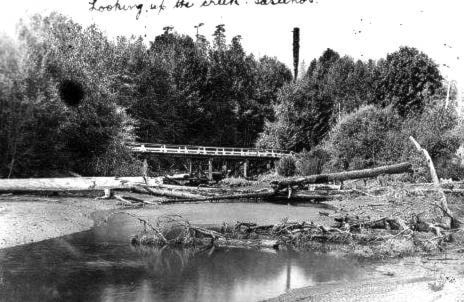Elida Peers | Contributed
In the 1920s and 1930s, this picture shows what Lannan Creek’s mouth looked like, immediately east of where Parklands Road meets Highway 14 in Saseenos.
Lannan Creek flows down to the inner basin from the Sooke Hills, and a few hundred yards before it reaches the harbour, it is joined by Saseenos Creek. This is the creek that runs through the ravine almost parallel to Highway 14, visible as far east as Woodlands Road.
Growing up in Saseenos, we kids were thrilled to watch the masses of salmon surging up the creeks to spawn each fall, but it’s a long time since we’ve seen salmon in those creeks.
Though the road was only gravel at the time, the subdivision of Saseenos, carried out by Alfred Carmichael Realty in 1920 and 1921, had brought several comfortably-off retired diplomats and distinguished personages to the new homesites that bordered the waterfront.
Immediately to the right (east) of this photo, there was a cottage and tearoom owned by a couple called Simpson.
For a time, the property was home to the nephew of a wartime Field Marshall General Wavell, who became Viceroy to India in 1943. Just east of that location, the Murdoch family of Oak Bay had a summer home. Beyond stood a place housing two retired missionaries, and then you reached the fine stuccoed house of Madame Anna Saunders.
Of the White Russian nobility, she escaped Petrograd during the Russian revolution by marrying British diplomat Capt. Saunders, reaching safety in Paris. Much later, this house became home to Max and Edna Elder, of Elder Logging.
As youngsters, we had a fascinating road to walk along, meeting and visiting with others along the way; motor vehicles were few and far between. One of the exciting things about Madame Saunders was that her dog Filo had two dog houses: the winter house was stuccoed and carpeted; the summer home was wood framed and airy.
At the left of this photo, the corner lot of Parklands Road was treed, but by 1940 a flat-roofed house rose on that corner, home to John and Ruth Hay
from Vancouver. Their youngsters grew up in the community, and many Sookites will know members of the Hay family. What I particularly remember about Ruth Hay was that she started Sooke’s first Parent-Teacher Association.
When the Second World War arrived, the road was busier with army vehicles driving west to the two army training camps; this bridge was replaced with a fill and culverts, and the road was paved.
•••
Elida Peers is the historian of the Sooke Region Museum.
editor@sookenewsmirror.com
Like us on Facebook and follow us on Twitter
